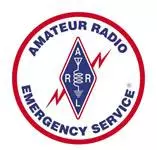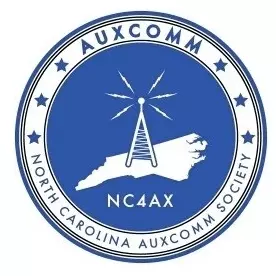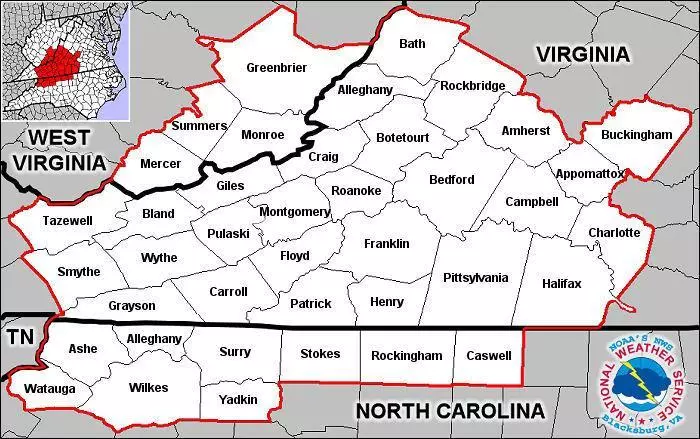W4FAR Repeaters (CTCSS 94.8) VHF:145.37 MHz (-); UHF: 443.55 MHz (+); DMR: 440.5375 (+)
Wilkes County A.R.E.S / AUXCOMM
Wilkes County Amateur Radio Emergency Service / Auxillary Communications
 Purpose of ARES®
Purpose of ARES®
Amateur Radio Emergency Service, which has developed since 1935, is a part of the American Radio Relay League (ARRL) Field Organization.
Part 97 of the FCC's RULES and REGULATION, which covers the Amateur Radio Service ,states under "Basis and Purpose" in 97.1 (a) that: "Recognition and enhancement of the value of the amateur service to the public as a voluntary non-commercial communication service, particularly with respect to providing emergency communications."
Amateurs have been involved with Public-service communications, emergency communications, since 1913. In the early days the involvement was unprepared and without any coordination. As stated in the PUBLIC SERVICE COMMUNICATIONS MANUAL, published by the ARRL, "As time progressed, the need for and value of organization became evident, resulting in the establishment of organized trunk lines and net systems; later the Amateur Radio Emergency Service (ARES) and the National Traffic System (NTS) were formed to complete the organization."
Today, "The Amateur Radio Emergency Service (ARES) consists of licensed amateurs who have voluntarily registered their qualifications and equipment for communications duty in the public service when disaster strikes. Every licensed amateur, regardless of membership in ARRL or any other local or national organization, is eligible for membership in the ARES. The only qualification, other than the possession of an Amateur Radio license, is a sincere desire to serve. Because ARES is an amateur service, only amateurs are eligible for membership. The possession of emergency-powered equipment is desirable, but is not a requirement for membership".
 Purpose of AUXCOMM
Purpose of AUXCOMM
AUXCOMM (Auxillary Communications), is a uniformly trained and credentialed unit of communication volunteers available for disaster response that would materially assist emergency preparedness and disaster response efforts across the state. While maintaining their traditional roles as Amateur Radio operators, many of these volunteers assist with the establishment and maintenance of communication facilities, assist with programming public safety radios during emergencies, and act as radio operators on public safety channels.
“AUXComm” is an umbrella term and acronym for “Auxiliary Communications.” It was developed by the OEC in 2009 with the assistance of amateur radio subject matter experts. The concept behind the acronym was to educate as many amateur radio entities to work and train with public safety personnel, understand the value of the National Incident Management System (NIMS) Incident Command System (ICS) concept and the role of the communications unit leader (COML). AUXComm, although not an official national ICS position as of yet, is most often identified as a Technical Specialist (THSP) in the Communications Unit of the NIMS ICS structure. North Carolina has endorsed AUXComm as an official position within their state NIMS/ICS structure.
Wilkes County ARES / AUXCOMM Leadership
| ARES Emergency Coordinator / AUXCOMM Coordinator: | Brian D. Lisle, AB1JU |
| ARES Assistant Emergency Coordinator / AUXCOMM Assistant Coordinator: | Stevie Howell, KO4COR |
| Wilkes County Emergency Manager: | Suzanne Hamby |
Training for ARES, AUXCOMM and RACES Required by North Carolina Emergency Management
NC Section ARES / AUXCOMM / RACES Training Policy
Our operations must comply with the National Incident Management System (NIMS). We operate under the Incident Command System (ICS) when activated.
The Department of Homeland Security (DHS) now requires all volunteers, including Amateur Radio operators to be certificated in at least IS 100,IS 200, IS 700 and IS 800 course material. For non-governmental employees and others without access to classroom instruction, these courses are available as on-line independent-study courses that are free of charge.
THOSE AMATEUR OPERATORS WHO MAY BE DEPLOYED TO EMERGENCY OPERATIONS CENTERS (EOCs), COMMAND POSTS, PUBLIC SAFETY ANSWER POINTS (911 CENTERS) OR OTHER POINTS WHERE INTERFACING WITH EMERGENCY MANAGEMENT OR GOVERNMENT OFFICIALS AT ANY LEVEL IS EXPECTED, ARE REQUIRED TO COMPLETE IS 100, IS 200, IS 700, and IS 800.
North Carolina Emergency Management Training Courses
These courses are mandated by the State of North Carolina. They are developed by the Federal Emergency Management Association (FEMA).
NOTE - the 100, 700 and 800 courses have been updated as of June 2018. If you already have those, it is recommended to take the updated ones again.
Download the ARES Field Manual
Available Resources for Wilkes County ARES / AUXCOMM
Hand-held Radio Cache (UHF)
Wilkes County ARES / AUXCOMM has not only personnel available to help with your group's communication needs (events such as a walkathon, run, hike, or bike ride) but we also have pre-configured hand-held radio sets available for loan - these hand-held radios are compatible with MURS and FRS (no license required) plus GMRS and Amateur Radio. If you might need some extra hand-held radios for your event, feel free to contact us.
ARES / AUXCOMM Working Frequencies / Channels
The below table is the Wilkes County ARES / AUXCOMM set of UHF simplex frequencies / channels that will be in use for any events. All ARES / AUXCOMM personnel should have these programmed into their radios.
UHF Cache Radios Channel Assignment
| Channel | Frequency | Label / Description |
|
1 |
464.5000 |
Brown Dot |
|
2 |
464.5500 |
Yellow Dot |
|
3 |
467.8500 |
Silver Star |
|
4 |
467.8750 |
Gold Star |
|
5 |
467.9000 |
Red Star |
|
6 |
462.5750 |
FRS 16/GMRS - White Dot |
|
7 |
467.9250 |
Blue Star |
|
8 |
462.6250 |
FRS 18/GMRS - Black Dot |
|
9 |
467.7625 |
"J" Dot |
|
10 |
462.6750 |
FRS 20/GMRS - Orange Dot |
|
11 |
467.8125 |
"K" Dot |
|
12 |
446.100 |
S4 (Amateur Radio Only) |
|
13 |
446.075 |
S3 (Amateur Radio Only) |
|
14 |
446.050 |
S2 (Amateur Radio Only) |
|
15 |
446.025 |
S1 (Amateur Radio Only) |
|
16 |
446.000 |
Call (Amateur Radio Only) |
Click here for a printable version of the frequency list:
Additional Resources for volunteer Personal Radio Services operators
The Personal Radio Services of the Federal Communications Commission include the Family Radio Service (FRS), the Multi-Use Radio Service (MURS), the Citizens Band Radio Service (CBRS), and the General Mobile Radio Service (GMRS). Transceivers using these services can be useful in emergency and disaster response situations. They may especially useful for very short range communications, such as within and among urban and suburban neighborhoods during CERT operations. Unlicensed FRS, MURS, and CB operators and licensed GMRS operators are encouraged to make use of the training resources designed for Amateur Radio operators. Here are some additional resources:
- FRS/GMRS frequency/channel table as of August 27, 2020
- Operator's manual for your transceiver
- Emergency Communications Training
- The ARRL Introduction to Emergency Communication (EC-001), available as an online course, as classroom training, and as self-study using the course transcript. This course is designed for licenced Amateur Radio operators, but it is open to all and is of significant value to all volunteer emergency communicators.
- Federal Communications Commission:
Grab - N - Go Kit
2M or 2M/70cm synthesized handheld radio
Alkaline battery pack and batteries for handheld radio
Car charger for HT
5/8 or wave gain antenna for handheld radio
Earphone for handheld radio
Copy of FCC radio license and ARES ID card with personal photo
Copy of radio manual (or ‘cheat sheet’) and frequencies stored in memory
Pouch/box with the following materials:
- ARES Field Resources Manual (www.arrl.org … #5439)
- ARRL North Carolina Section Guide (www.ncarrl.org/ncep.pdf)
- N.I.F.O.G. version 1.4 (for printable copy click here)
- ICS 217a for Wilkes County (see the Wilkes County EC)
- Wilkes County 10 Code and EMS Codes (see the Wilkes County EC)
- SkyWarn Protocol (Blacksburg NWS)…(www.wx4rnk.org)
- Wilkes County ARES Protocol (see the Wilkes County EC)
- Map of Wilkes County (Wilkes Chamber of Commerce)
- ARRL Message Forms (www.arrl.org)
- Sheets of blank paper / radio log
- Pens and pencils
50 feet of coax (RG8 mini or better) with PL259 connectors
Miscellaneous connectors and adapters (PL259, BNC, SMA, barrel, etc.)
Flashlight (AA)
Personal first aid kit
Five dollars in bills and change
Pocket knife / Multi-tool
Roll of electrical tape
Any special size tools your radio uses like tiny screwdrivers, etc
Battery operated AM/FM radio
Scanner (and accessories) with local public service (optional)
Water (2 quarts minimum)
Light snacks
Your "favorite" pain relievers - Aspirin / Tylenol / Advil / Aleve / Sinus or Allergy Medicine / Rolaids or Tums / Chap Stick /
Hand cream / Throat lozenges / Imodium / Sun block / Mosquito repellant / etc.
National Weather Service
Skywarn
The effects of severe weather are felt every year by many Americans. To obtain critical weather information, NOAA’s National Weather Service (NWS), part of the U.S. Department of Commerce, established SKYWARN® with partner organizations. SKYWARN® is a volunteer program with nearly 290,000 trained severe weather spotters. These volunteers help keep their local communities safe by providing timely and accurate reports of severe weather to the National Weather Service.
Although SKYWARN® spotters provide essential information for all types of weather hazards, the main responsibility of a SKYWARN® spotter is to identify and describe severe local storms. In the average year, 10,000 severe thunderstorms, 5,000 floods and more than 1,000 tornadoes occur across the United States. These events threatened lives and property.
Since the program started in the 1970s, the information provided by SKYWARN® spotters, coupled with Doppler radar technology, improved satellite and other data, has enabled NWS to issue more timely and accurate warnings for tornadoes, severe thunderstorms and flash floods.
SKYWARN® storm spotters are part of the ranks of citizens who form the Nation’s first line of defense against severe weather. There can be no finer reward than to know that their efforts have given communities the precious gift of time–seconds and minutes that can help save lives.
How does SKYWARN work?
SKYWARN, generally speaking, is placed on stand-by when a severe weather watch is posted by the National Weather Service. Once that watch is upgraded to a warning, SKYWARN may be activated and spotters are asked to make severe weather observations. After making an observation that is reportable, there are three ways to relay the information to the National Weather Forecast Office which include: telephone, amateur radio, and E-mail.
How do I become a SKYWARN Spotter?
All you need to do to become a member of the SKYWARN volunteer network is an interest in watching the sky and a dedication to helping save lives. You must be at least 16 years old, be able to observe weather (though no instruments are required), and have access to a telephone, internet, or be a licensed amateur radio operator so you can relay your reports by radio. You also must take a SKYWARN class, a free seminar that teaches you the basics of how SKYWARN operates, and how to recognize and report severe weather. All SKYWARN spotter training courses are free and are held in various sites throughout the 40 county NWS Blacksburg area of responsibility (see map below).

